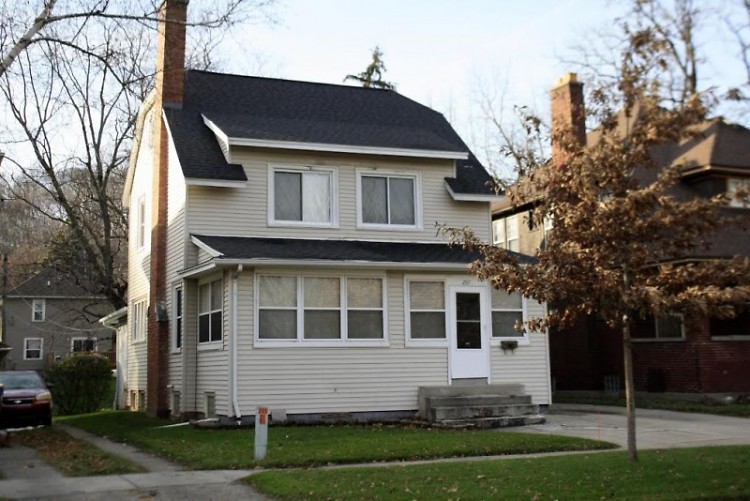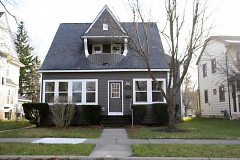Nestled in Grand Rapids' lower Westside neighborhood of John Ball Park lies a nearly 13-acre haven, a reprieve for people like myself who had not previously thought of living in the city, let alone falling in love with it and wanting to raise my family here. Lincoln Park was established as part of the Grand Rapids Park System in 1873 and named after Abraham Lincoln. Since its establishment, it has been known for and cherished among Westside residents as an oasis of nature’s beauty, shaded by hundred year old oak, maple, catalpa and once birch lined pathways.
The houses surrounding Lincoln Park are some of the largest and most architecturally rich in the entire lower west side. Once owned by the wealthier factory and small business owners of the Westside, likely of Polish or German ancestry, these houses and this park hopped with social activity for well over a century. Over the past decade or two, the former oasis grew increasingly derelict as the area's furniture and auto factories closed and, after them, mom-and-pop shops closed making way for larger stores in the neighboring suburbs.
It was just after the height of the 2008 housing crisis that my now wife of nearly five years and I fell in love with the people, culture and community of the Westside and began dreaming of purchasing one of the houses on Lincoln Park. The particular house we dreamt of was one of the hundreds of foreclosures on the Westside during this time, but it was special.
It was the only house on the park built as a duplex, with a combined nearly 3,000 square feet of finished space. It was fronted with large white brick front porch with four sculpted pillars. The inside was finished with original hardwood flooring and trim, bay windows and a third story waiting to be made into additional living space. The location on Lincoln Park was practically just a bonus to the potential of this house.
We walked past the house almost every day, called the banks to find out when it would come on the market and even had an investor lined up to help make the cash purchase. Several months later, it all came to an end when we caught wind from the bank that it was sold, essentially to an insider with the mortgage holding company, who put a little work into it and has rented strictly to college students ever since.
Nearly five years later, my work within the nonprofit community on the Westside and personal pursuit to purchase a home has brought me face-to-face with the reality of the fleeting availability of affordable homes to both rent and purchase. On a weekly basis I find myself in conversation with or hearing stories about neighbors from all over the Westside who are being forced out of their homes from rising rent prices. The only way my family has been able to stay in the neighborhood renting is by way of friends and family willing to temporarily lower their typical asking rent.
The plight of trying to find affordable rental housing or a reasonable housing purchase for me and my Westside neighbors is in fact due to the very thing so many of us have hoped for our neighborhood: revitalization. For years now Grand Rapids' Westside has been referred to as “the gritty Westside” by various media outlets while painting a picture of its rapid growth as the next hotbed in the city for development and inexpensive space for tech companies, breweries, market-rate apartments and high-end condos.
To paint a picture, in 2000 the area median household income (AMI) on the lower west side was about $32,800; median rent paid was $500/month and the percentage of renters spending greater that 30% of their income on rent was 33%.
Fast forward to 2013 and the AMI fell to $29,300; rent increased to roughly $747/month and 58% of renters were spending more than 30% of their monthly income on rent (data provided by Community Research Institute). In addition a recent housing market analysis of the City of Grand Rapids reported that almost 40% of the Westside is living at or below poverty, meaning 40% of Westside residents are impacted directly by the availability of affordable housing here.
While there are various other systemic issues at work as well, these statistics are very real and highlight a nearly insurmountable hurdle for the working class families that are proud to call the Westside home. The tricky dynamic of revitalization that is at play promises jobs and improvement in other areas of neighborhood life, but drives demand on the existing housing stock and simply put, is out-pricing and displacing residents before any benefits are realized to them.
The impact of the demand for housing is seen in part in who owns and rents the homes. Homes once owned by “mom & pop” as long-term retirement investments are being sold to investment groups and individuals looking to capitalize in the short-term on the high demand for college housing close Grand Valley State University’s Pew campus. While not inherently wrong in our capitalist society, it has played out as highly discriminating and disruptive in our community.
Mom and pop used to personally know who they rented to. They gave them breaks from time to time if finances were rough. They took chances on renting to individuals with bad or no credit or others with felony convictions. They were willing to build relationship and stick it out and rent to people for the long hall, sometimes 20 or more years.
It’s now common for new investors to simply act as pocketbooks and pass off all responsibility to a growing handful of management companies. These investors out-compete potential homeowners by offering cash and buying at auction, increasing the ratio of renter vs. owner-occupied housing in the area. In the best interest of their investors, management companies are heavily screening renters for credit, requiring proof of two or three times monthly rent as income and clear criminal backgrounds. Houses are often maximized for square footage by enclosing front porches, landscaping is removed or minimized, kitchens are renovate to high-end appliances and then rent per room rather than household, often charging $400+ per month per room for a three bedroom home that likely formerly rented at $800-$1000 per month.
These changes on the housing infrastructure and availability are seismic. Over the past year, rising rental rates displaced enough families that falling student enrollment in part led to Shamut Hills Elementary closing a classroom and laying off a teacher. Numerous students once promised a last dollar scholarship through the Challenge Scholars program have also been displaced losing that opportunity.
Affordable housing on the Westside isn’t just about individuals or about ability to pay bills anymore. It’s about a community being threatened. It’s about the opportunity and education of the next generation. It’s about each individual’s story as a part of the Westside community. It’s about the culture, the history, the pride of our Westside.
The Rapidian, a program of the 501(c)3 nonprofit Community Media Center, relies on the community’s support to help cover the cost of training reporters and publishing content.
We need your help.
If each of our readers and content creators who values this community platform help support its creation and maintenance, The Rapidian can continue to educate and facilitate a conversation around issues for years to come.
Please support The Rapidian and make a contribution today.



Comments
This is super important. Thanks. It's definitely not just happening to the Westside, but it's important to thoroughly analyze each area where people Grand Rapidians are being hurt by displacement, market rate developments, and unfeeling property management companies.